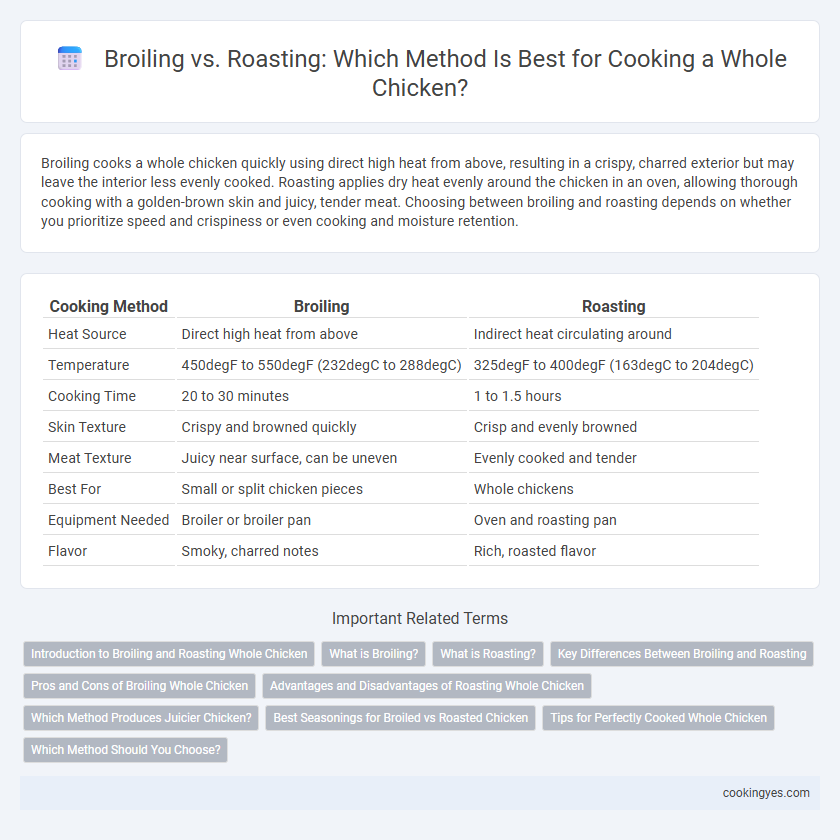Broiling cooks a whole chicken quickly using direct high heat from above, resulting in a crispy, charred exterior but may leave the interior less evenly cooked. Roasting applies dry heat evenly around the chicken in an oven, allowing thorough cooking with a golden-brown skin and juicy, tender meat. Choosing between broiling and roasting depends on whether you prioritize speed and crispiness or even cooking and moisture retention.
Table of Comparison
| Cooking Method | Broiling | Roasting |
|---|---|---|
| Heat Source | Direct high heat from above | Indirect heat circulating around |
| Temperature | 450degF to 550degF (232degC to 288degC) | 325degF to 400degF (163degC to 204degC) |
| Cooking Time | 20 to 30 minutes | 1 to 1.5 hours |
| Skin Texture | Crispy and browned quickly | Crisp and evenly browned |
| Meat Texture | Juicy near surface, can be uneven | Evenly cooked and tender |
| Best For | Small or split chicken pieces | Whole chickens |
| Equipment Needed | Broiler or broiler pan | Oven and roasting pan |
| Flavor | Smoky, charred notes | Rich, roasted flavor |
Introduction to Broiling and Roasting Whole Chicken
Broiling a whole chicken involves cooking it under direct high heat, which quickly sears the skin for a crispy texture while keeping the inside moist. Roasting uses even, indirect heat in an oven, allowing the chicken to cook slowly and develop a tender, evenly browned exterior. Both methods enhance flavor but differ in cooking time and texture outcomes.
What is Broiling?
Broiling is a cooking method that uses direct high heat from above to quickly cook the surface of a whole chicken, creating a crispy, caramelized exterior while keeping the inside juicy. This technique typically employs the oven's broiler setting, placing the chicken close to the heat source to achieve intense, fast cooking. Broiling is ideal for smaller cuts or finishing touches but can be challenging for cooking a whole chicken evenly compared to roasting.
What is Roasting?
Roasting is a dry-heat cooking method that uses indirect, consistent heat to cook a whole chicken evenly, typically in an oven at temperatures between 325degF and 450degF. This technique produces a tender interior and a crispy, golden-brown skin by slowly rendering fat and caramelizing the chicken's surface. The slow cooking process ensures moisture retention while developing rich flavors and a uniform texture throughout the bird.
Key Differences Between Broiling and Roasting
Broiling cooks a whole chicken using intense direct heat from above, resulting in a crispy, browned exterior while keeping the interior moist, ideal for quick cooking and surface caramelization. Roasting involves cooking the chicken evenly in an oven with indirect heat, allowing for thorough cooking and tender, evenly browned meat throughout. Broiling is best for smaller cuts or crisping skin, whereas roasting is preferred for whole chickens to achieve consistent internal temperature and juiciness.
Pros and Cons of Broiling Whole Chicken
Broiling a whole chicken offers the advantage of rapid cooking and a crispy, caramelized skin due to the direct high heat, which enhances flavor and texture. However, this method can result in uneven cooking, with the risk of the exterior becoming charred while the interior remains undercooked, especially in larger birds. Broiling also requires close attention to prevent flare-ups and generally suits smaller chickens or portions rather than whole large chickens for consistent results.
Advantages and Disadvantages of Roasting Whole Chicken
Roasting whole chicken delivers evenly cooked meat with crisp, golden skin and allows for the incorporation of herbs and vegetables, enhancing flavor complexity. The method requires longer cooking times compared to broiling, often leading to higher energy use and potential dryness if overcooked. Roasting's consistent, indirect heat is ideal for thorough cooking but may lack the intense, caramelized surface texture achieved by broiling.
Which Method Produces Juicier Chicken?
Broiling cooks chicken using intense direct heat from above, often resulting in a crispy exterior but can dry out the meat if overcooked. Roasting uses indirect, evenly distributed heat, allowing the whole chicken to cook slowly and retain moisture for juicier, tender results. For juicier whole chicken, roasting is generally preferred due to its balanced heat and longer cooking time that helps preserve internal juices.
Best Seasonings for Broiled vs Roasted Chicken
Broiling whole chicken intensifies flavor with high heat, making bold seasonings like smoked paprika, garlic powder, and cayenne pepper ideal to complement the charred exterior. Roasting allows for slower, even cooking, ideal for herbaceous blends such as rosemary, thyme, lemon zest, and garlic, which infuse deeper, aromatic flavors throughout the meat. Using oil-based marinades with ingredients like olive oil, Dijon mustard, and fresh herbs enhances moisture retention and seasoning absorption in both broiling and roasting methods.
Tips for Perfectly Cooked Whole Chicken
Broiling a whole chicken creates a crispy skin quickly by exposing it to high, direct heat, ideal for smaller birds or finishing touches, while roasting cooks evenly with indirect heat, perfect for larger chickens ensuring juicy meat. For perfectly cooked whole chicken, use a meat thermometer to reach an internal temperature of 165degF (74degC), and let the chicken rest for 10-15 minutes before carving to retain juices. Season the chicken with herbs and a light oil coating before cooking to enhance flavor and promote even browning.
Which Method Should You Choose?
Broiling cooks a whole chicken quickly using high direct heat, resulting in a crispy exterior but risk of uneven cooking. Roasting uses moderate, consistent oven heat that evenly cooks the chicken while retaining moisture and developing rich flavors. Choose roasting for tenderness and even cooking, while broiling suits smaller cuts or when you desire a charred, crispy skin in less time.
Broiling vs Roasting for cooking whole chicken Infographic

 cookingyes.com
cookingyes.com